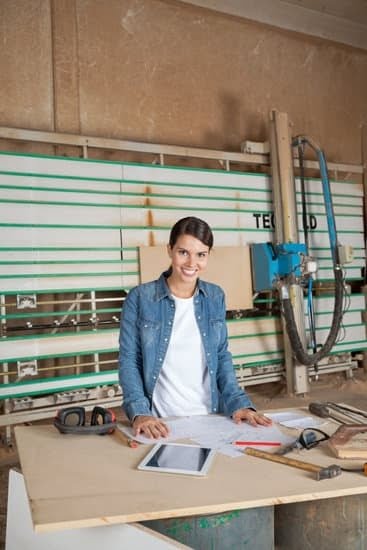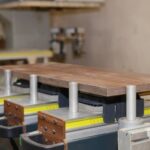Woodworking is a craft that demands precision and attention to detail. Accurate measurement is essential in ensuring the success and quality of woodworking projects. Whether it’s crafting furniture, cabinetry, or intricate woodcarvings, accurate measurements act as the foundation upon which these creations are built.
Accurate measurement in woodworking carries significant importance. Measurements determine the dimensions, proportions, and overall functionality of a piece. Without precise measurements, there is a risk of ending up with ill-fitting joints, unstable structures, or pieces that don’t align correctly. Inaccurate measurements can lead to wasted materials, time-consuming reworks, and compromised safety.
Safety is another critical consideration when it comes to accurate measurement in woodworking. Incorrect measurements can result in improperly fitting pieces or weak connections, compromising the structural integrity of a project. This can pose hazards not only during construction but also for the end-users of the finished piece.
In addition to precision and safety concerns, accurate measurements facilitate consistency and reproducibility in woodworking projects. When creating multiple identical pieces or working on larger projects, precise measurements ensure that each component fits seamlessly together. Consistency in joinery techniques and component sizing is key in achieving both visual harmony and functional reliability.
In this article, we will explore why accurate measurement plays such a vital role in woodworking. We’ll examine how precise measurements act as the cornerstone of successful woodworking projects and discuss their relationship with safety considerations. Additionally, we’ll delve into how accurate measurements contribute to achieving consistency and reproducibility while accounting for wood movement. Finally, we will explore the impact of accurate measurement on aesthetics and provide an overview of essential measuring tools and techniques utilized by woodworkers.
By understanding the importance of accurate measurement in woodworking from both practical and artistic perspectives, aspiring woodworkers can hone their skills while ensuring exceptional craftsmanship in their creations.
Measurement as the Foundation of Woodworking
Accurate measurements serve as the foundation of successful woodworking projects. Woodworking is a precise craft that requires careful attention to detail, and accurate measurements are essential in achieving the desired dimensions, proportions, and overall functionality of a piece. Without precise measurements, woodworking projects can quickly become flawed and result in a waste of time, money, and materials.
Before starting any woodworking project, it is crucial to pre-plan and take precise measurements. Measurements dictate the size and shape of every component, ensuring that they fit together seamlessly. Additionally, accurate measurements help woodworkers create pieces that not only look visually appealing but also function properly. Whether it’s determining the length of a board or calculating the angle for a miter cut, accuracy in measurement plays a fundamental role in achieving the intended design.
Taking accurate measurements goes hand-in-hand with enhancing safety in woodworking. Incorrect measurements can result in improperly fitting pieces or unstable structures. This can lead to accidents and injuries when working with power tools or during assembly. When pieces don’t align correctly due to inaccurate measurements, it compromises the integrity of the entire piece and increases the risk of accidents. It is essential to prioritize safety by consistently double-checking and verifying all measurements throughout the woodworking process.
To achieve consistency and reproducibility in woodworking projects, accurate measurement is vital. Precision allows woodworkers to create multiple identical pieces effortlessly or work on larger projects where each component needs to fit seamlessly together. Consistency ensures uniformity across different parts of a project while reproducibility ensures that if something needs to be replaced or replicated later on, it will match perfectly.
In summary, accurate measurement is critical in woodworking as it forms the foundation for successful projects. Precise measurements ensure proper dimensions, proportions, and functionality while enhancing safety throughout the process. Consistency and reproducibility are achieved through accurate measurements leading to seamless joinery techniques for visually appealing projects. By prioritizing accuracy in measurement and using appropriate tools correctly, woodworkers can achieve high-quality, precise results in their craft.
Safety Considerations and Accurate Measurement
Accurate and precise measurement is not only important for achieving quality and precision in woodworking projects, but it also plays a crucial role in ensuring safety. Proper measurements help to create well-fitting pieces and stable structures, reducing the risk of accidents and injuries.
When measurements are inaccurate, pieces may not fit together properly, leading to unstable structures or weak connections. This can pose significant safety hazards as the integrity of the project may be compromised. For example, if the dimensions of a support beam are measured incorrectly, it may not be able to bear the intended load, posing a risk of collapse or structural failure.
Inaccurate measurements can also result in improperly fitted components. For instance, if the dimensions of joints are not measured correctly, they may be loose or ill-fitting. This can weaken the overall structure and increase the likelihood of accidents while handling or using the finished piece.
To ensure safety in woodworking projects, it is essential to take accurate measurements throughout the entire process. This starts with pre-planning and careful consideration of dimensions before starting any project. Using reliable measuring tools correctly, such as tape measures, rulers, and calipers, is also crucial for accurate measurements.
Proper measurement techniques should be followed when marking out joinery methods like mortise and tenon joints or dovetails. Precise measurements allow for seamless joinery and fitting of components, enhancing both the structural integrity and safety of the finished piece.
Overall, accurate measurement goes beyond achieving quality woodworking results; it is an essential aspect of ensuring safety in every woodworking project. By taking precise measurements at each stage of a project and using reliable measuring tools correctly, woodworkers can minimize the risk of accidents caused by ill-fitting pieces or unstable structures.
| Accurate Measurement | Safety Considerations |
|---|---|
| Ensure well-fitting pieces and stable structures | Reduce risk of accidents and injuries |
| Prevent weak connections and structural failure | Maintain the integrity of the project |
| Avoid improperly fitted components | Enhance overall safety when handling or using the finished piece |
| Promote seamless joinery and fitting of components | Improve structural integrity of the finished piece |
Achieving Consistency and Reproducibility through Accurate Measurement
Accurate measurement in woodworking is not only crucial for achieving precision and quality in individual projects, but it also plays a significant role in achieving consistency and reproducibility when working on multiple identical pieces or larger projects. Consistency refers to the ability to replicate measurements and dimensions accurately, while reproducibility pertains to the ability to produce identical results or pieces consistently.
Importance of Consistency
Consistency is vital when creating multiple identical pieces, such as chairs or cabinets. Without accurate measurements, each piece may vary slightly in size or proportion, leading to inconsistencies in the final product. In woodworking, even slight variations can be noticeable and result in a lack of uniformity that affects the overall aesthetic appeal and functionality of the completed project. For example, if the measurements for chair legs are inconsistent, it can lead to an unsteady piece of furniture.
Moreover, consistency allows for efficient production when working on large-scale woodworking projects. Being able to reproduce accurate measurements ensures that components fit together seamlessly and reduces time spent on adjustments during assembly. This efficiency is particularly important for professional woodworkers who often take on commissions or have strict project deadlines.
Ensuring Reproducibility
Reproducibility goes hand-in-hand with consistency in woodworking. It involves creating multiple pieces or duplicating previous work with precision and accuracy. Accurate measurements enable woodworkers to replicate successful designs and ensure that each subsequent piece matches the original specifications precisely.
To achieve reproducibility, it is important to document accurate measurements during every step of a woodworking project. This includes noting down specific dimensions, angles, joinery techniques used, as well as any necessary adjustments made along the way.
Furthermore, precise measurements allow for seamless joinery and fitting of components. When designing a project that requires multiple pieces fitting together smoothly – such as a drawer or a set of shelves – accurate measurements ensure that all the parts align perfectly, resulting in a final product that looks visually appealing and functions flawlessly.
By prioritizing accuracy in measurement, woodworkers can achieve consistency and reproducibility, leading to high-quality woodworking projects that meet both functional and aesthetic requirements. Whether creating multiple identical pieces or tackling larger projects, accurate measurement is essential for achieving uniformity, efficiency, and precision in woodworking.
Understanding Wood Movement and Accurate Measurement
Wood movement is a natural phenomenon that occurs in wood due to changes in humidity and temperature. It is crucial for woodworkers to understand this process and consider it when making accurate measurements for their projects. Failing to account for wood movement can lead to costly mistakes and compromised structural integrity.
Accurate measurement plays a crucial role in accounting for wood movement because it allows woodworkers to anticipate and plan for the potential expansion and contraction of the wood. When wood absorbs moisture, it swells, causing its dimensions to increase. Conversely, when the moisture content decreases, either due to low humidity or exposure to heat, the wood shrinks. These changes can lead to warping, cracking, or even joint failure if not properly accounted for in the design and measurements.
To ensure accurate measurements while considering wood movement, there are several practices that woodworkers should follow. First, it is essential to measure and record the initial moisture content of the wood before any cutting or shaping takes place. This baseline measurement serves as a reference point throughout the project. Additionally, it is crucial to allow sufficient space for expansion and contraction in joinery techniques such as dovetails or mortise and tenon joints.
Woodworking projects often require multiple components that need to fit together precisely. Accurate measurement ensures that each piece will maintain its size relative to others despite changes in humidity and temperature. By accounting for wood movement during the planning and measuring stages, woodworkers can create durable and visually appealing pieces that will withstand environmental changes over time.
Role of Accuracy in Joinery Techniques
Joinery techniques are a fundamental aspect of woodworking, allowing for the creation of strong and durable connections between wood components. Accurate measurement plays a critical role in achieving successful joinery, ensuring that the pieces fit together seamlessly and securely. Whether it’s mortise and tenon joints, dovetails, or other forms of joinery, precise measurements are key to creating structurally sound and aesthetically pleasing woodworking projects.
When it comes to joinery, accurate measuring and marking out is essential to ensure the proper fit of the joints. Measurements dictate the dimensions and proportions of the joint components, determining how they will interlock or overlap with one another. Inaccurate measurements can result in loose or ill-fitting joints that compromise the stability and strength of the overall structure.
For example, when creating mortise and tenon joints, precise measurements are crucial for determining the exact size and placement of both the mortise (the hole) and tenon (the protruding piece). If these measurements are even slightly off, the joint may not fit tightly or snugly, leading to weak connections that can easily come undone over time.
Similarly, when crafting dovetail joints, accurate measurements are essential for achieving tight-fitting interlocking angles. The pins on one component must perfectly match the tails on another component for a secure connection. Any discrepancies in measurements can result in loose or misaligned dovetails that compromise both the structural integrity and aesthetics of the joint.
In addition to precise measuring techniques, proper use of marking tools such as pencil or marking knives is crucial for ensuring accuracy in joinery. These tools allow woodworkers to transfer their measurements onto the workpiece with precision, creating clear guidelines for cutting or shaping.
Overall, accurate measurement is paramount in joinery techniques to create solid connections that withstand time. By understanding the criticality of precise measuring and marking out in different types of joinery methods, woodworkers can ensure sturdy structures and enhance the overall craftsmanship and quality of their woodworking projects.
The Impact of Inaccurate Measurement on Aesthetics
Accurate measurements play a crucial role in achieving visually appealing woodworking projects. In this section, we will explore the impact of inaccurate measurement on aesthetics and how precise measurements contribute to the overall craftsmanship of a woodworking project.
Asymmetry, Uneven Spacing, and Misaligned Components
One of the consequences of inaccurate measurement in woodworking is the potential for asymmetry, uneven spacing, or misaligned components. When measurements are not precise, it can lead to pieces that do not fit together properly or are not evenly spaced. This can result in a finished product that lacks visual balance and cohesion.
For example, imagine constructing a set of shelves where the measurements for each shelf’s height and width are just slightly off. The end result may be shelves that appear crooked or unevenly spaced when installed. Similarly, if measurements for joinery such as dovetails or mortise and tenon joints are even slightly off, it can lead to visible gaps or ill-fitting connections.
Contributing to Overall Aesthetics and Craftsmanship
Achieving accurate measurements contributes to the overall aesthetics and craftsmanship of a woodworking project. Precise measurements allow for consistent proportions and symmetrical designs, enhancing the visual appeal of the finished piece. Whether it’s a table with perfectly aligned legs, or cabinets with seamless joinery, accurate measurements ensure that every component fits together harmoniously.
Additionally, accurate measurement helps create refined details that elevate the craftsmanship of a woodworking project. For example, precise measurements enable clean and well-fitting moldings or panel inserts. These details enhance the overall aesthetic value of the piece and showcase the skill level of the woodworker.
The Tools and Techniques for Accurate Measurement in Woodworking
In conclusion, accurate measurement is of utmost importance in woodworking for several reasons. Firstly, it serves as the foundation of any successful woodworking project. Accurate measurements determine the dimensions, proportions, and overall functionality of the piece being created. Without precise measurements taken during pre-planning stages, the project is likely to suffer from issues such as ill-fitting pieces or unstable structures.
Furthermore, accurate measurement directly correlates with safety in woodworking. Incorrect measurements can lead to improperly fitting components or weak joinery connections, posing potential hazards. Inaccurately measured cuts or joinery techniques may result in compromised stability and increased likelihood of accidents.
Achieving consistency and reproducibility in woodworking projects also relies heavily on accurate measurement. Precise measurements allow for seamless joinery and fitting of components, making it possible to create multiple identical pieces or work on larger projects without discrepancies.
Additionally, accurate measurements are crucial for accounting for wood movement. Wood expands and contracts with changes in humidity and temperature, which can have significant consequences if not considered during the design and measurement stages. Ignoring wood movement could result in warped or misaligned components over time.
The role of accuracy extends into various joinery techniques as well. Measurement precision is critical when working with mortise and tenon joints, dovetails, and other common methods. Failing to accurately measure and mark these joints can lead to loose or ill-fitting connections that compromise the integrity of the final piece.
Finally, accurate measurement plays a vital role in achieving aesthetically pleasing woodworking projects. Incorrect measurements can result in asymmetry, uneven spacing, or misaligned components that detract from the overall visual appeal and craftsmanship of the piece.
To ensure accurate measurement in woodworking, utilizing proper tools and techniques is essential. Basic measuring tools such as tape measures, rulers, and calipers are indispensable for obtaining precise measurements. Knowing how to use these tools correctly will help woodworkers achieve greater accuracy in their work. Additionally, tips and techniques for measuring irregular or curved surfaces accurately are valuable skills that woodworkers should strive to master.
Frequently Asked Questions
Why is it important to use accurate measurements?
Accurate measurements are important because they ensure precision and consistency in any project or task. Whether it’s carpentry, cooking, or engineering, using accurate measurements is crucial to achieving desired results.
In carpentry specifically, accurate measurements are essential for creating well-fitted joints, ensuring proper alignment of pieces, and maximizing the overall quality and functionality of the finished product. Without accurate measurements, carpenters risk compromising the structural integrity and aesthetic appeal of their work.
How accurate does woodworking need to be?
Woodworking typically requires a high level of accuracy due to the nature of the materials involved and the desired outcome. While there may be some room for creativity and individual style in certain woodworking projects, precision is key when it comes to fitting pieces together effectively and achieving optimal functionality.
For example, if a woodworker is making a cabinet with sliding drawers, precise measurements are necessary to ensure that the drawers fit smoothly and seamlessly within their designated spaces. Overall, woodworking should strive to achieve as much accuracy as possible in order to produce high-quality work that meets both functional requirements and aesthetic standards.
What is the importance of measuring tool in carpentry?
Measuring tools are extremely important in carpentry as they provide woodworkers with the means to obtain accurate measurements. There is a wide range of measuring tools available in carpentry, including tape measures, straight edges, squares (like framing squares or combination squares), calipers, levels, rulers, and more.
These tools help carpenters determine lengths, widths, angles, heights, depths, and other dimensions necessary for planning layouts and cutting materials precisely.

Hi everyone! I’m a woodworker and blogger, and this is my woodworking blog. In my blog, I share tips and tricks for woodworkers of all skill levels, as well as project ideas that you can try yourself.





